Stone Adversaries – Ruskin’s Rocks, Hejduk’s Diamonds
Paper by Anthony Auerbach read at the Architectural Drawings Symposium, Shatwell, 24 April 2016.
I would like to introduce two items from this collection, or rather two collections our host has brought together, whose cohabitation here prompted me to consider whether they are related and whether the relation can be traced in a history of drawing.
The first (chronologically) is a collection of mineral samples arranged by John Ruskin (1819–1900) and donated by him to St. David’s School, Reigate, in 1883, with a printed catalogue. [1]
The second is a printed portfolio by John Hejduk (1929–2001), published by The Cooper Union School of Art and Architecture in New York in 1969. The ‘Three Projects’ of the title are known as ‘The Diamond Projects’ and are dated 1963–67. [2]
Whereas Ruskin and Hejduk both have respectable claims to a place in the history of architecture, those stones of Ruskin’s and these diamonds of Hejduk’s don’t obviously qualify for a collection of drawings. The collector of drawings is usually, and here also for the most part, a collector of autographs. These aren’t autographs. Some of the stones of the first set are cut and polished, they are labelled, but not inscribed, except by the forces of nature. The second set are lithographs, in this case not inscribed stones, but mechanical reproductions of mechanical-looking drawings.
Nor is it obvious what the two collections have to do with architecture, despite the reputations and institutional status of the two men. Hejduk’s and Ruskin’s interests were not confined to architecture and neither Ruskin’s cabinet nor Hejduk’s three projects had any consequence in the world of building. Given their different contexts, the pedagogical aims the two collections don’t necessarily bring them closer to one another or much closer to drawing or architecture.
We could suggest what Ruskin and Hejduk might have in common: the wish for a broader cultural and moral engagement than the disciplined practice of architecture or art criticism would allow; a wish for the authority, indeed the heroism, of genius; an affection for myth and mystery; a certain bewilderment and isolation. Yet, despite what the men may have had in common a century apart, the two collections, side by side, show their divergence.
Ruskin, one may say, was a naturalist and there is evidence for this in his approach to drawing and to mineralogy. A life-long amateur mineralogist and collector, Ruskin found in minerals models of geological structure and natural form. Observation of the natural forms of rocks and crystals provided Ruskin with material for a moral pedagogy that is no less present in his lectures to learned societies than in his homilies intended for children.
Hejduk, one may say, was an idealist and he displayed in his ‘Diamond Thesis’ (as he called this publication) a commitment to abstraction that was at that time mediated by his reception of the post-cubist avant-gardes of the inter-war period in Europe. In his introduction to the projects, Hejduk refers to several leading protagonists of the avant-garde: the painters Piet Mondrian and Theo van Doesburg, founders of De Stijl and co-promoters of neoplasticism before van Doesburg struck out on his own with elementarism; Charles-Édouard Jeanneret, best known as Le Corbusier, who, with the painter Amedée Ozenfant, promoted purism through their organ L’ésprit nouveau; and Ludwig Mies van der Rohe, the architect once associated with the Bauhaus, and one of several prominent refugees who enjoyed influential careers in the United States as designers and teachers following the dissolution of the school in Germany.
The Diamond Thesis concerns itself explicitly, in Hejduk’s words, with ‘certain essences’, ‘basic relationships’ and ‘generating principles’ which he identifies with quasi-geometric ‘problems’ that the earlier modernist avant-gardes had advertised along with their rejection of perspective in painting (a polemic mainly directed at impressionism), and with the implicit notion of technical drawing as a model of rational structure and ideal form.
Before tracing these divergent trajectories back to where they cross, let’s look a bit closer at the two collections and restore them to their original contexts.
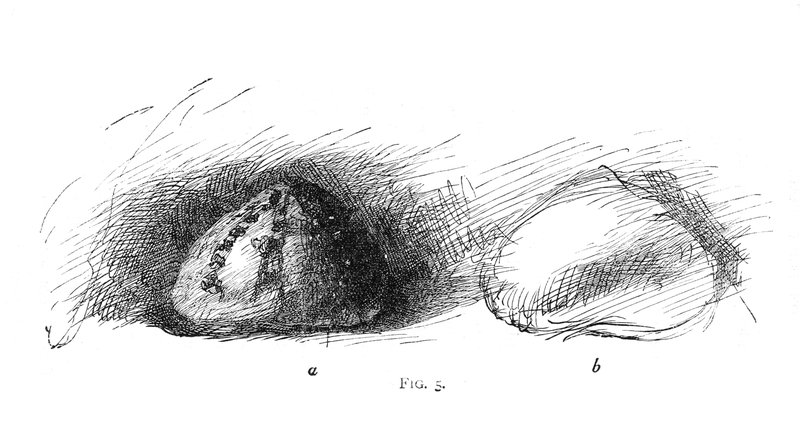
‘Now if you can draw that stone, you can draw anything; I mean, anything that is drawable. […] if you can draw the stone rightly, everything within reach of art is also within yours.’ [3]
This ‘stone antagonist’ (Fig. 1) from The Elements of Drawing (1857), which had its counterpart in the present collection, [4] is the foundation of Ruskin’s proposition of the practice of drawing as the study of nature. ‘Nature,’ he tells us, ‘is all made up of roundnesses’ [5] whose imperfect forms are disclosed by light and shadow. The stone is the compact form not only of the inexhaustible fascination Ruskin found in natural materials, but also of his notion of the correspondence between nature and art. Knowledge of nature, acquired, above all, by the practice of drawing, Ruskin claims, is the very basis of aesthetics, of all judgment of art. [6] A course in drawing, for Ruskin, ought to be the basis of ‘a system of education in Natural History’. [7]
Whereas the teaching of perspective theory was the mainstay of the academies of art, just as geometry had been the legendary gatekeeper of the Platonic academy, Ruskin’s Elements paid only ironic tribute to Euclid. Although he had apparently enjoyed pure geometry since he was a boy, Ruskin excluded the theory of perspective from his instruction in drawing because he thought it was painful to students and of little practical use to painters. He made good the omission in The Elements of Perspective (1859), a book which Ruskin’s editors tell us was for the author a pleasure to write, [8] but of no importance to his mission.
Other writings on mineralogy, geology and landscape as well as architecture, art and art training qualified Ruskin’s notion of the knowledge of nature and sharpened his scorn for the instruments and manners of science. ‘The laws of right,’ he maintained, are ‘based upon man’s nature, not upon his knowledge.’ [9]
The correspondence of nature and art which gave moral purpose to the latter, and justified Ruskin’s own judgement of it, would also justify The Ethics of the Dust (1866), [10] a book in which the natural phenomena of crystallisation were presented for the moral education of ‘little housewives,’ as he called them, despite the protests of the puppet-girls he imagined in dialogue with a Socratic the old lecturer.
An address to the Mineralogical Society (‘On The Distinctions of Form in Silica’, 1884) [11] laid out his purpose in arranging collections such as the one now in the Drawing Matter collection (Fig. 2) and in providing the catalogues he claimed would ‘enable any student to follow out the history of siliceous minerals with reference to the best possible cabinet examples.’ [12] Thus Ruskin appealed to children to provide him with a reflection of his own boyish enthusiasm and hence the affirmation that the learned community denied him. Ruskin pointed out, not entirely humourlessly, that ‘though an old member of the Geological Society, my geological observations have always been as completely ignored by that society, as my remarks on political economy by the Directors of the Bank of England’. [13] He puzzled why, compared with his writings on art, his scientific writings had so little influence on the public ‘though,’ he asserted, ‘precisely the same faculties of eye and mind are concerned in the analysis of natural and pictorial forms’. [14]

Yet, the catalogues are, in fact, desultory and conflicted. Ruskin compounds his puerile excitement with the condescending manner of a connoisseur; the expert’s jargon with the frank admission that the specimens are to him ‘totally incomprehensible’ [15] or indeed ‘entirely indescribable by any human language’; [16] and he spoils the gift of natural treasure with the avarice of a collector’s pride.
Hejduk possibly became as mystified by the dejected elements of architecture as Ruskin was by his fragments of nature. Ruskin himself makes a shadowy appearance in Hejduk’s Mask of Medusa via a reference, in recollecting The Diamond Projects, to The Failing Distance, an obscure book by Jay Fellows on ‘The Autobiographical Impulse’ in Ruskin. [17] Whereas Ruskin’s impulse was homiletic, Hejduk’s is hermetic. Mysterious, barely articulated, and slightly threatening, his later work especially is widely regarded as ‘profoundly significant’ [18] and is taken rather seriously.
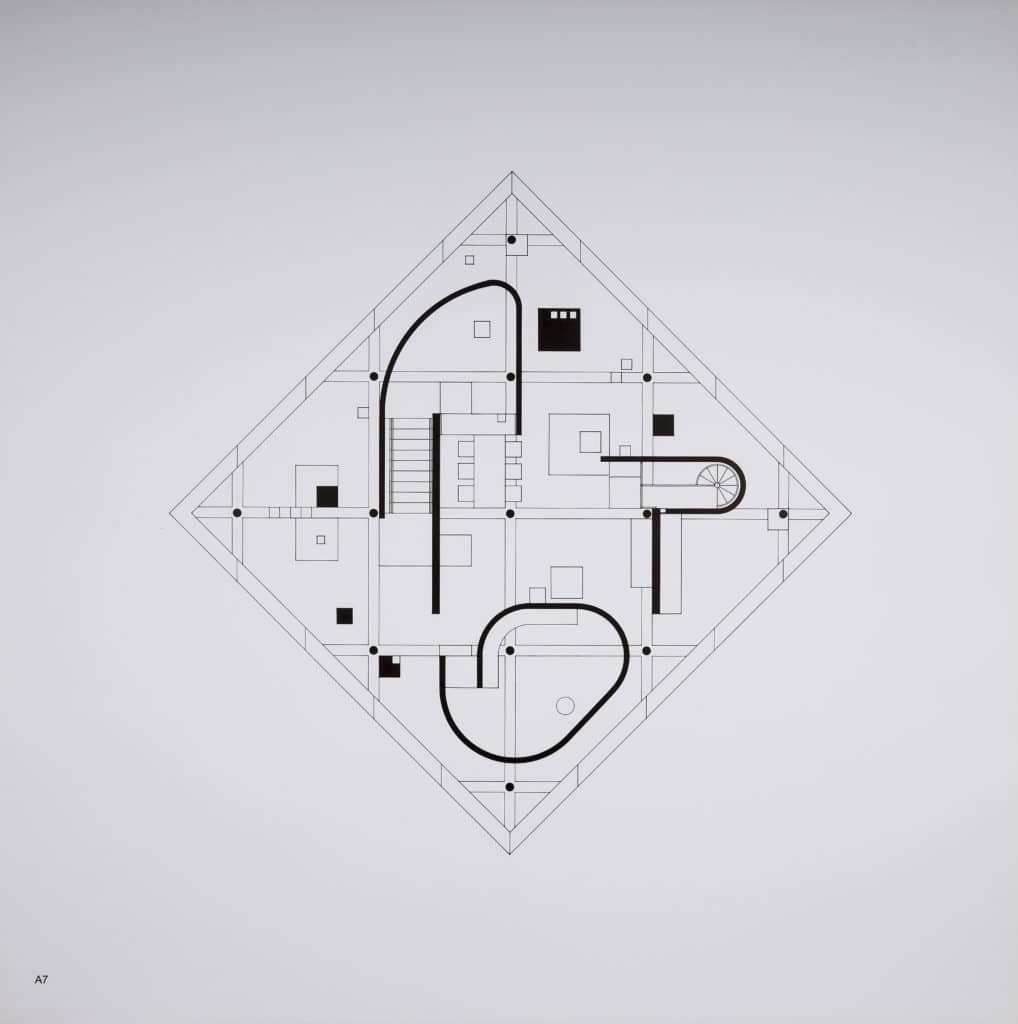
Let’s approach these Three Projects more lightly. These drawings have no shadows (Fig. 3). They are set firmly in the language of technical drawing: rectilinear, unmodulated, form-determining. Thus the drawings announce themselves as projects, though they are deprived of the apparatus which would give them meaning for a builder, [19] as well as of the rendering of material and illumination which would make them pictures. The gesture and mimicry of the work, as the accompanying text affirms, refer to painting and architecture (architecture being not-yet-building) of the 1920s. Indeed, the text does not make any sense except as an echo, almost a parody, of the avant-gardist debate that raged after cubism. Hejduk appears as an unreconstructed modernist and was praised for his ‘attempt to revivify the mystical modernist faith in the meaning of abstract spatial signs.’ [20] But what was he playing at?
One cue Hejduk takes is from Mondrian’s tableaux lozangiques or diamond compositions (1918–1944), [21] where the painter rotated a square canvas 45° while maintaining the horizontal-vertical orientation of the composition; and possibly from Van Doesburg’s Contra-compositions, where (perhaps to spite his former comrade) the design was also allowed to rest at 45° in an upright frame. This break in Van Doesburg’s habit, incidentally, was prompted by an encounter with the practices of architecture and interior design. The other cue is from a drawing method that became closely associated with modernist architecture in the 1920s. Here the plan is rotated on the sheet (conventionally 45° or 30°) and the elevations are attached, resulting in a quasi-three-dimensional view which is easy to draw and quite well adapted to simple cubic volumes. Hejduk discovered that if your plan is already a diamond composition, then one of the exterior elevations disappears and the result is reminiscent of the flattened or tipped-up appearance of objects in cubist and, perhaps, especially purist painting (Fig. 4).
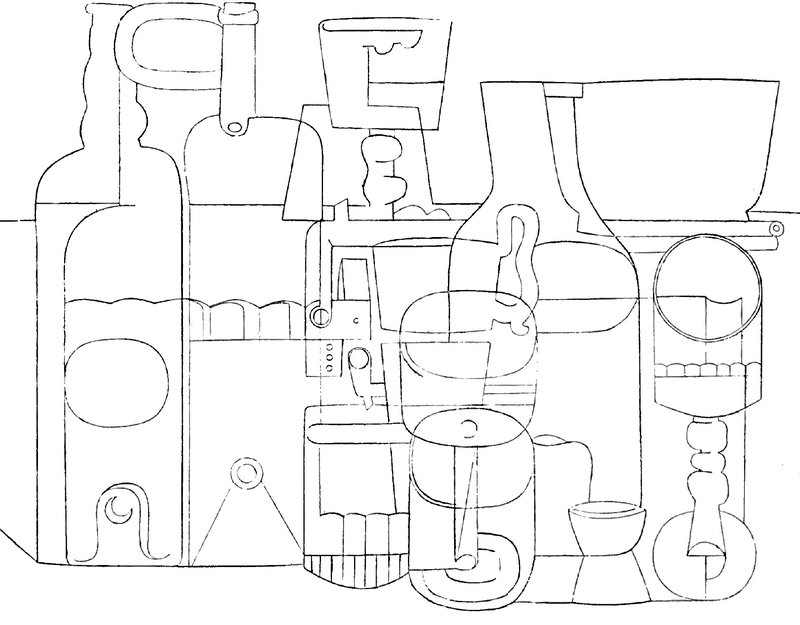
The advantage to an architect of the drawing method which Hejduk incorrectly calls ‘isometric projection’ (often and also confusingly called ‘axonometric’), is that it preserves the true shape of the plan and the true height of the elevation. The method can be conceived, or explained as an oblique projection but in practice no projection is performed. [22]
Hejduk’s idea is that ‘a diamond form […] projected by isometric […] becomes a square’ and that this ‘self-evident truth’ had never been seen before in architectural drawings. ‘The isometric projections of the diamond,’ he claims, ‘are Cubist projections in architecture.’ Later, Hejduk found out that the cubist effect had nothing to do with diamonds, but only with a slightly unconventional use of oblique ‘projection’ and he may have realised that the geometric lesson to be learned from Mondrian is that the so-called diamond canvas and the square canvas are the same thing.
‘The banal,’ Hejduk said, ‘is … the strangeness of being caught between Europe and America.’ [23]
It would be unfair to expect from Hejduk a coherence that the earlier pretenders to the mantle of the avant-garde did not possess. The dismembered tradition that Hejduk himself helped canonise had found refuge in the United States, in part as museum-pieces, memorials to modernist aspirations engulfed by war, in part in the service of adapting such ideals to building the international style.
The sublime distance from which modernism appeared to Hejduk made it seem to him that the disjointedness of the array of parts he was able to muster, as if ready for an assembly line, was his American sensibility. [24] That distance may have transmitted only a dim awareness of the faults by which modernism’s syncretic doctrine was cleft, and little knowledge of its sources, contradictions or the feedback effects that once had amplified a critic’s remark about ‘bizarreries cubiques’ (that could have made Pascal and Cézanne turn in their graves) [25] into a mystical promise.
The true cubists, according to Jeanneret and Ozenfant, would exhibit ‘une tendance vers le cristal’ emblematic of nature’s affirmation of man’s geometrical mind, (‘l’esprit géométrique’). [26]

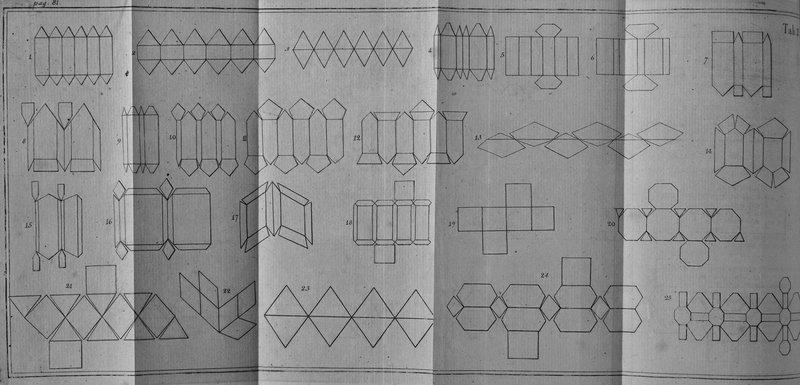
The rationalisation of mineralogy towards the end of the eighteenth century — this is the point where the lineages of Ruskin’s rocks and Hejduk’s diamonds converge — began by mining the naturalist’s cabinet of wonders. As a descriptive, taxonomic project, crystallography was understood (in part) as a problem in solid geometry, and hence one that could be worked out in drawing. Carl Linnaeus, in his Systema Naturae (12th edition, 1768) supplemented illustrative sketches of the order of minerals with developed surfaces which explain the three-dimensional shapes of the examples (Fig. 5). Lacking the techniques and theories which would later transform the field he helped to define as a scientific discipline, René Just Haüy’s Traité de la Minéralogie (1801) relied more on geometry than physics or chemistry. Haüy’s notion of structure was almost completely hypothetical and his argument rested on the double foundation of drawing and mathematics.
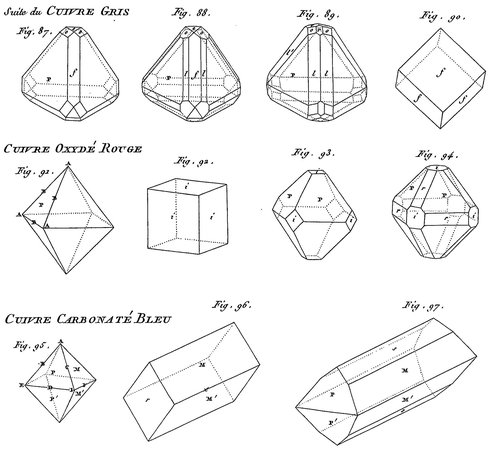

In so far as the book is, in Haüy’s words, ‘a kind of graphic treatise on the laws of structure,’ [27] it displays a faith in both the descriptive and the theoretical aspects of geometrical drawing founded on Monge’s Géométrie descriptive, the textbook which became cornerstone of the polytechnic tradition. [28] However, instead of the formalised orthography of Monge’s method of engineering drawing, the Traité makes use of ad hoc pictorial ‘projections’ to better illustrate its points (Fig. 6). Such drawings survived their growing irrelevance to the conduct of science and continued to be reproduced as icons of nature’s lawfulness and of man’s geometrical right to legislate. While Haüy had remarked that for most people minerals were just ‘masses brutes, sans physiognomie et sans langage’, [29] such drawings suggested the physiognomy and language of knowledge itself.
A cubist leafing through Goldschmidt’s monumental Atlas der Krystallformen (1913–23) [30] could have discovered a case of nature imitating art (Fig. 7).
Notes
1. Collection no. 2128. The catalogue is also in volume XXVI, 491–513, of The Works of John Ruskin, ed. by E. T. Cook and Alexander Wedderburn, London: George Allen, 39 volumes, 1903-1912, hereinafter cited Works by volume.
2. Collection no. 2303.
3. Works XV, 49, §42. ‘Many things,’ says Ruskin ‘(sea foam, for instance) cannot be drawn at all, only the idea of them more or less suggested; but if you can draw the stone rightly, everything within reach of art is also within yours.’ Sea foam, also known as meerschaum, or écume de mer (magnesium silicate), incidentally, would have a rightful place in a cabinet of siliceous minerals.
4. ‘Look your stone antagonist boldly in the face,’ writes Ruskin.Works XV, 50, §43. A similar fossil, cut in half and recorded in Ruskin’s catalogue of the Reigate collection, is now missing. ‘I cut the little Echinus, F. 20, through the middle to see into his mind, but made nothing of it, and only lost the other half of him.’ Works XXVI, 513.
5. ‘Boughs are rounded, leaves are rounded, stones are rounded, clouds are rounded, cheeks are rounded, and curls are rounded: there is no more flatness in the natural world than there is vacancy. The world itself is round, and so is all that is in it, more or less, except human work, which is often very flat indeed.’ Works XV, 50.
6.Works XV, 82, §94.
7. Fors Clavigera, Letter 60 (1875), Works XXVIII, 461.
8. ‘A holiday task.’ Works XV, xxv.
9. The Seven Lamps of Architecture, 1849. Works VIII, 21. Conversely, Ruskin asserted in his Deucalion (collected writings on geology and mineralogy, 1875): ‘the reader may take it for a first principle, both in science and in literature, that the feeblest myth is better than the strongest theory: the one recording a natural impression on the imaginations of great men, and of unpretending multitudes; the other an unnatural exertion of the wits of little men, and half-wits of impertinent multitudes.’ Works XXVI, 99.
10. Works XVIII, 199–368.
11. Works XXVI, 373–391.
12. Works XXVI, 387.
13. Works XXVI, 373.
14. Works XXVI, 386. ‘A quick eye, a candid mind, and an earnest heart, are all the microscopes and laboratories which any of us need.’ Works XXVI, 385.
15. Works XXVI, 492.
16. Works XXVI, 497.
17. Hejduk replies to the interviewer, ‘A recession of time, the recession of time into the past is in perspective and it’s volumetric. Jay Fellows writes of this in the Failing Distance. It’s a beautiful distance …’ The Mask of Medusa: Works 1947–1983, New York: Rizzoli, 1985, 50. The reference is to Jay Fellows, The Failing Distance: The Autobiographical Impulse in John Ruskin, Baltimore and London: The Johns Hopkins University Press, 1975. A quotation from this book also appears an epigraph in The Mask of Medusa (55). Fellows was a colleague of Hejduk’s at Cooper Union and was invited to take part in the teaching of architecture by Hejduk in 1977. He contributed an essay on Ruskin to a volume documenting the participation of several extra-disciplinary figures to the architecture programme (Solitary Travellers, New York: The Cooper Union School of Architecture, 1980). He is the author of another book on Ruskin and a book on Walter Pater (another conservative English art critic of the Victorian era), like The Failing Distance, highly stylised on the model of French post-structuralism. Fellows is also one of the dedicatees of Hejduk’s Victims (1986). He died in 1990 from alcoholism.
18. Daniel Liebeskind writes in the introduction to Mask of Medusa: ‘To say that his work is of profound significance or that it is deeply inspiring is only to utter the obvious.’ 9.
19. Hejduk’s note stating the buildings (Project A: a house, B: unspecified, C: a museum) are supposed to be ‘poured in place concrete’ with certain modular dimensions and painted in primary colours and white is no more than a statement of modernist orthodoxy with a gesture granting an architectural benediction to the drawings.
20. ‘… by matching the convention of pictorial flatness to the ground plan of architecture.’ Richard Pommel, ‘Structures for the Imagination’ Art in America, March–April 1978, in Mask of Medusa, 58.
21. See E. A. Carmean, Mondrian: The Diamond Compositions, Washington DC: National Gallery of Art, 1979.
22. Axonometric assumes parallel projectors perpendicular to the plane of projection and, except for planes parallel to the plane of projection, produces foreshortening. Isometric is a special case of axonometric in which the foreshortening in each dimension is the same. This is usually explained as a ‘view’ of a specimen cube along the diagonal joining opposite vertices, thus showing three faces of the cube. These ‘projections’ are normally practiced as flat drawing methods using instruments such as the 30/60/90-degree triangle, which helps constructing isometrics. The same instruments can also be used for drawing oblique ‘projections’ such as were popularised in the inter-war years. The projective rationale of these methods assumes parallel projectors which are not perpendicular to the plane of projection, hence the term oblique projection. The flat methods that are used in practice are very old and do not involve any geometry. Nonetheless, the appearance of such drawings, adapted to simple cubic forms — the rudimentary forms, much as they were presented in nineteenth-century schoolbooks on the ‘elements’ of technical or ‘mechanical’ drawing — came, in the twentieth century, to be regarded as a hallmark of modernism, and thereby associated with exaggerated geometrical claims — claims in part also derived from the nineteenth-century schoolbooks. See P. J. Booker, A History of Engineering Drawing, London, 1963 , 211–212.
23. Mask of Medusa, 53.
24. Mask of Medusa, 53.
25. Louis Vauxcelles, Gil Blas, 25 March 1909.
26. Amedée Ozenfant and Charles-Edouard Jeanneret, La Peinture Moderne, Paris: Crès, 1925, 11. The authors elaborate: ‘Le cristal est, dans la nature, un des phénomènes qui nous touchent le plus parce qu’il nous montre clairement ce cheminement vers l’organisation géométrique. … Le cristal, qui pousse, s’arrête en dehors suivant les formes théoriques de la géométrie; et l’homme se complaît à ces agencements parce qu’il y trouve comme la justification des conceptions abstraites de la géométrie: l’esprit de l’homme et de la nature trouvent un facteur commun, un terrain d’entente, dans le cristal comme dans la cellule, partout où l’ordre est sensible au point qu’il justifie les lois humaines d’explication de la nature que la raison s’est complue à édicter.’
27. René Just Haüy, Traité de la Minéralogie, Paris: Louis, 1801, li.
28. Having been declared a military secret by the ancien régime, the method was not publicly taught until after the revolution in France. Gaspard Monge (1746–1818) was instrumental in the establishment of the École de Travaux Publics (the future École Polytechnique) and the École Normale. The book, compiled by his students and published at the end of the century was honoured as canonical, even if it was not rigorously taught. Géométrie descriptive Paris: Baudouin, 1799.
29. Traité de la Minéralogie, ii.
30. Victor Goldschmidt, Atlas der Krystallformen, Heidelberg: Carl Winter, 9 volumes with 9 volumes of plates, 1913–1923.
